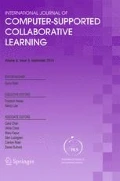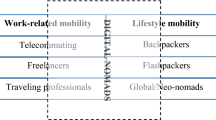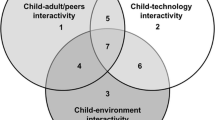Abstract
Interactive, digital mapping technology is providing new pedagogical possibilities for children and their families, as well as new methodological opportunities for education researchers. Our paper reports on an example of this novel terrain we call “Community Technology Mapping” (CTM). CTM was a designed task that was part of a larger ethnographic study of children and families’ digital media and technology practices in and around their homes. CTM incorporated interactive digital mapping technology with a structured interview protocol as a pedagogical context for young people and a methodological tool for researchers. As a pedagogical context for computer-supported collaborative learning, CTM supported young people to see and reflect on their everyday technological practices as temporally and spatially organized across scales of human interaction. As a methodological tool, CTM allowed researchers to see families’ place-based and on-the-move activities that were outside the more naturalistic observations of home-based technology use. Our analysis of CTM draws upon video recordings and screen captures of young people’s reflections on and live mappings of places they typically used technology and engaged with media. We found that children developed strategies with the mapping technology to make places visible, make them coherent, and make them mobile. These strategies produced a “cascade of inscriptions” within the CTM task for mapping new mobilities of digital, daily life. We argue that interactive digital mapping technologies not only support researchers to ask new questions about the spatiotemporal aspects of learning phenomena, but also contribute to a new genre of place-based, digital literacies- locative literacy- for learners to navigate.




Similar content being viewed by others
References
Barker, J., Kraftl, P., Horton, J., & Tucker, F. (2009). The road less travelled- new directions in children’s and young people’s mobilities. Mobilities, 4(1), 1–10.
Barron, B., Martin, C. K., Takeuchi, L., & Fithian, R. (2009). Parents as learning partners in the development of technological fluency. International Journal of Learning and Media, 1(2), 55–77.
Bingham, N., & Thrift, N. (2000). Some new instructions for travelers: The geography of Bruno Latour & Michael Serres. In Crang & N. Thrift (Eds.), Thinking Spaces. New York: Routledge.
Bowker, J., & Star, S. L. (1999). Sorting things out: Classification and its consequences. Cambridge: MIT Press.
boyd, d. (2014). It’s complicated: The social lives of networked teens. New Haven: Yale University Press.
Bryant, A., & Charmaz, K. (2007). Grounded theory methods and practice. In A. Bryant & K. Charmaz (Eds.), The SAGE handbook of grounded theory. SAGE: Los Angeles.
Callon, M. (1986). Some elements of a sociology of translation: Domestication of the scallops and the fishermen of St. Brieuc Bay. In J. Law (Ed.), Power, action, and belief: A new sociology of knowledge? (pp. 196–233). London: Routledge.
Cazden, C., Cope, B., Fairclough, N., Gee, J., et al. (1996). A pedagogy of multiliteracies: Designing social futures. Harvard Educational Review, 66(1), 60–92.
Chi, M. T. H. (1997). Quantifying qualitative analyses of verbal data: A practical guide. The Journal of the Learning Sciences, 6(3), 271–315.
Cole, M. (2006). The fifth dimension: An after-school program built on diversity. New York: Russel Sage Foundation.
Cole, M., & Griffin, P. (1983). A socio-historical approach to re-mediation. Quarterly Newsletter of the Laboratory of Comparative Human Cognition, 5(4), 69–99.
Crampton, J. W. (2010). Mapping: A critical introduction to cartography and GIS. Wiley-Blackwell.
Cress, U., Stahl, G., Ludvigsen, S., & Law, N. (2015). The core features of CSCL: Social situation, collaborative knowledge processes and their design. International Journal of Computer-Supported Collaborative Learning, 10, 109–116.
diSessa, A. A. (1997). Changing minds: Computers, learning, and literacy. Cambridge: MIT Press.
Ellegård, K., & Hägerstrand, T. (1977). Activity organization and the generation of daily travel: Two future alternatives. Economic Geography, 53(2), 126–152.
Elwood, S. (2010). Geographic information science: emerging research on the societal implications of the geospatial web. Progress in Human Geography, 34(3), 349–357.
Elwood, S., & Leszczynski, A. (2012). New spatial media, new knowledge politics. Transactions of the Institute of British Geographers, 38, 544–559.
Enyedy, N. (2005). Inventing mapping: Creating cultural forms to solve collective problems. Cognition and Instruction, 23(4), 427–466.
Enyedy, N., & Mukhopadhyay, S. (2007). They don’t show nothing I didn’t know: Emergent tensions between culturally relevant pedagogy and mathematics pedagogy. The Journal of the Learning Sciences, 16(2), 139–174.
Erickson, F. (2004). Talk and social theory: Ecologies of speaking and listening in everyday life. Cambridge, UK: Polity Press.
Erstad, O. (2011). The learning lives of digital youth-beyond the formal and informal. Oxford Review of Education, 38(1), 25–43.
Farman, J. (2010). Mapping the digital empire: Google Earth and the process of postmodern cartography. New Media & Society, 12(6), 869–888.
Freire, P., & Macedo, D. (1998). Literacy: Reading the word and the world. Thinking, 14, 1.
Friedman, T. L. (2016). Thank you for being late: An optimist’s guide to thriving in the age of acceleration. New York: Farrar, Straus & Giroux.
Gee, J. P. (2003). What video games have to teach us about learning and literacy. New York: Palgrave Macmillan.
Gee, E., Takeuchi, L. M., & Wartella, E. (Eds.). (2017). Children and families in the digital age: Learning together in a media saturated culture. New York: Routledge.
Glaser, B. G., & Strauss, A. L. (1967). The discovery of grounded theory: Strategies for qualitative research. New Brunswick: Aldine Transaction Publishers.
Goffman, E. (1979). Footing. Semiotica, 25, 1–29.
Goodwin, C. (2013). The co-operative, transformative organization of human action and knowledge. Journal of Pragmatics, 46, 8–23.
Goodwin, M. H., & Goodwin, C. (2012). Car talk: Integrating texts, bodies, and changing landscapes. Semiotica, 191(1), 257–286.
Goodwin, M. H., & Goodwin, C. (2013). Nurturing. In E. Ochs & T. Kremer-Sadlick (Eds.), Fast-forward Family: Home, work, and relationships in middle-class America. Berkeley: University of California Press.
Gordon, E., Elwood, S. & Mitchell, K. (2016). Critical spatial learning: Participatory mapping, spatial histories, and youth civic engagement. Children’s Geographies, 14(5), 558–572.
Graesch, A. P. (2013). At home. In E. Ochs & T. Kremer-Sadlick (Eds.), Fast-forward family: Home, work and relationships in middle-class America. Berkeley: University of California Press.
Hall, R. & Stevens, R. (2016). Interaction analysis approaches to knowledge in use. In A.A. diSessa, M. Levin, and N.J.S. Brown (Eds.), Knowledge and interaction: A synthetic agenda for the learning sciences. New York: Routledge.
Hall, R., Ma, J. Y., & Nemirovsky, R. (2015). Rescaling bodies in/as representational instruments in GPS drawing. In V. Lee (Ed.), Learning technologies and the body: Integration and implementation in formal and informal learning environments. New York: Routledge.
Hart, R. (1977). Children’s experience of place: A developmental study. New York: Irvington Publishers.
Higgins, S. E., Mercier, E., Burd, E., & Hatch, A. (2011). Multi-touch tables and the relationship with collaborative classroom pedagogies: A synthetic review. Computer-Supported Collaborative Learning, 6, 515–538.
Hontvedt, M., & Arnseth, H. C. (2013). On the bridge to learn: Analysing the social organization of nautical instruction in a ship simulator. Computer-Supported Collaborative Learning, 8, 89–112.
Ingold, T. (1993). The temporality of the landscape. World Archaeology, 25, 152–174.
Ingold, T. (2011). Being alive: Essays on movement, knowledge and description. London: Routledge.
International Society for Technology in Education. (2016). ISTE national educational technology standards (NETS). Retrieved from http://www.iste.org/docs/Standards-Resources/iste-standards_students-2016_one-sheet_final.pdf?sfvrsn=0.23432948779836327.
Ito, M., Baumer, S., Bittanti, M., boyd, d., Cody, R., et al. (2010). Hanging out, messing around, and geeking out: Kids living and learning with new media. Boston: MIT press.
Ito, M., Gutierrez, K., Livingstone, S., Penuel, B., Rhodes, J., et al. (2013). Connected learning: An agenda for research and design. Irvine: CA: Digital Media and Learning Research Hub.
Jenkins, H., Ito, M., & Boyd, d. (2016). Participatory culture in a networked era. Cambridge, UK: Polity.
Jenson, O. B., Sheller, M., & Wind, S. (2015). Together and apart: Affective ambiences and negotiation in families’ everyday life and mobility. Mobilities, 10(3), 363–382.
Jordan, B., & Henderson, A. (1995). Interaction analysis: Foundations and practices. Journal of the Learning Sciences, 4(10), 39–103.
Kerdeman, D. (2003). Challenging self-understanding as a focus of teaching and learning. Journal of Philosophy of Education, 37(2), 293–308.
Kimiko, R., & Agogino, A. (2013). Off the paved paths: Exploring nature with a mobile augmented reality learning tool. International Journal of Mobile Human Computer Interaction, 5(2), 21–49.
Kingston, R. (2010). Mind over matter?: History and the spatial turn. Cultural and Social History, 7(1), 111–121.
Lammes, S. (2016). Digital mapping interfaces: From immutable mobiles to mutable images. New Media & Society, 1–15.
Latour, B. (1986). Visualisation and cognition: Thinking with eyes and hands. In H. Kuklick (Ed.), Knowledge and society studies in the sociology of culture past and present. Jai Press, 6, 1–40.
Latour, B. (1987). Science in action. Ch. 6, Centres of calculation, 215–257.
Latour, B. (1991). Technology is society made durable. In J. Law (Ed.), A sociology of monsters: Essays on power, technology and domination. London: Routledge.
Latour, B. (1999). Circulating reference: Sampling the soil in the Amazon forest. In Pandora’s hope: Essays on the reality of science studies. Cambridge: Harvard University Press.
Lave, J. (1988). Cognition in practice: Mind, mathematics & culture in everyday life. New York: Cambridge University Press.
Lave, J., & Wenger, E. (1991). Situated learning: Legitimate peripheral participation. Cambridge, UK: Cambridge University Press.
Leander, K. M., Phillips, N. C., & Taylor, K. H. (2010). The changing social spaces of learning: Mapping new mobilities. Review of Research in Education, 34(1), 329–394.
Lemke, J. L. (2000). Across the scales of time: Artifacts, activities, and meanings in ecosocial systems. Mind, Culture, and Activity, 7, 273–290.
Linde, C. (1993). Life stories: The creation of coherence. New York: Oxford University Press.
Ma, J. (2016). Designing disruptions for productive hybridity: The case of walking scale geometry. Journal of the Learning Sciences, 25(3), 335–371.
Ma, J. Y., & Munter, C. (2014). The spatial production of learning opportunities in skateboard parks. Mind, Culture, and Activity, 21(3), 238–258.
NGSS Lead States. (2013). Next generation science standards: for states, by states (interdependent relationships in ecosystems). Retrieved from http://www.nextgenscience.org/.
November, V., Camacho-Hubner, E., & Latour, B. (2010). Entering a risky territory: Space in the age of digital navigation. Environment and Planning D: Society and Space, 28, 581–599.
Patterson, T. C. (2007). Google Earth as a (not just) geography education tool. Journal of Geography, 106(4), 145–152.
Phillips, N. C. (2013). Investigating adolescents’ interpretations and reproductions of thematic maps and map argument performances in the media. (Doctoral dissertation, Vanderbilt University).
Pink, S., & Mackley, K. L. (2013). Saturated and situated: Expanding the meaning of media in the routines of everyday life. Media, Culture & Society, 35(6), 677–691.
Pink, S., Horst, H., Postill, J., Hjorth, L., Lewis, T., & Tacci, J. (2016). Digital ethnography: Principles and practice. Los Angeles: SAGE.
Radinsky, J. (2017). Data on the move. Talk presented at Learning on the Move Workshop. Nashville, TN.
Roschelle, J. & Pea, R. (2002). To unlock the learning value of wireless mobile devices, understand coupling. Proceedings of the IEE International Workshop on Wireless and Mobile Technologies in Education. Växjö, Sweden.
Roschelle, J., & Teasley, S. (1995). The construction of shared knowledge in collaborative problem-solving. In C. E. O’Malley (Ed.), Computer supported collaborative learning (pp. 69–97). Heidelberg, Germany: Springer-Verlag.
Rudwick, M. (1976). The emergence of a visual language for geological science, 1760–1840. History of Science, 14, 149–195.
Santo, C. A., Ferguson, N., & Trippel, A. (2010). Engaging urban youth through technology: The youth neighborhood mapping initiative. Journal of Planning Education and Research, 30(1), 52–65.
Shapiro, B., Hall, R., & Heiberger, L. (2015). Assembling American roots music: Visitors’ micro-curation and engagement in museum gallery spaces. Paper presented at the Annual Meetings of the Association of American Geographers, Chicago, IL.
Shapiro, B., Hall, R., & Owens, D. A. (2017). Developing & using interaction geography in a museum. International Journal of Computer-Supported Collaborative Learning, 12, 377–399.
Stahl, G., Ludvigsen, S., Law, N., & Cress, U. (2014). CSCL artifacts. International Journal of Computer-Supported Collaborative Learning, 9, 237–245.
Star, S. L. (1990). Power, technology and the phenomenology of conventions: On being allergic to onions. The Sociological Review, 28(1), 26–56.
Star, S. L. (1999). The ethnography of infrastructure. American Behavioral Scientist, 43(3), 377–391.
Stevens, R. (2000). Divisions of labor in school and in the workplace: Comparing computer and paper-supported activities across settings. The Journal of the Learning Sciences, 9(4), 373–401.
Stevens, R., & Hall, R. (1998). Disciplined perception: Learning to see in technoscience. In M. Lampert & M. L. Blunk (Eds.), Talking mathematics in school: Studies of teaching and learning (pp. 107–150). New York: Cambridge University Press.
Takeuchi, L., & Stevens, R. (2011). The new co-viewing: Designing for learning through joint media engagement. A report of The Joan Ganz Cooney Center at Sesame Workshop and LIFE Center.
Tate, W. F. (2008). Geography of opportunity: Poverty, place, and educational outcomes. Educational Researcher, 37(7), 397-411.
Taylor, K. H. (2017). Learning along lines: Locative literacies for reading and writing the city. Journal of the Learning Sciences, 26(4), 533–574.
Taylor, K.H. & Phillips, N. (2017). Place-making. In K. Peppler, (Ed.), The Encyclopedia of Out-of-school Learning Time. New York: SAGE.
Taylor, K. H., & Hall, R. (2013). Counter-mapping the neighborhood on bicycles: Mobilizing youth to reimagine the city. Technology, Knowledge and Learning, 18(1–2), 65–93.
Taylor, K. H., & Silvis, D. (2017). Mobile city science: Technology-supported collaborative learning at community scale. Paper presented at the Conference on Computer Supported Collaborative Learning (CSCL 2017). Philadelphia, PA: International Society of the Learning Sciences.
Taylor, K.H., Takeuchi, L. & Stevens, R. (2017a). Mapping the daily media round: Novel methods for understanding families’ mobile technology use. Learning, Media and Technology, 1–15.
Taylor, K. H., Silvis, D., & Stevens, R. (2017b). Collecting and connecting: Intergenerational learning with digital media. In E. Gee, L. M. Takeuchi, & E. Wartella (Eds.), Children and families in the digital age: Learning together in a media saturated culture. New York: Routledge.
Twenge, J. "Have smartphones destroyed a generation?" The Atlantic, Sept. 2017, https://www.theatlantic.com/magazine/archive/2017/09/has-the-smartphone-destroyed-a-generation/534198/.
Umphress, J., & Sherin, B. (2015). The body as viewfinder: Using wearable cameras in learning research. In V. Lee (Ed.), Learning technologies and the body: Integration and implementation in formal and informal learning environments. New York: Routledge.
Verhoeff, N. (2012). Mobile screens: The visual regime of navigation. Amsterdam University Press.
Vertesi, J. (2008). Mind the gap: The London underground and the users’ representations of urban spaces. Social Studies of Science, 38(1), 7–33.
Vygotsky, L. S. (1978). Mind in society: The development of higher psychological processes. Cambridge: Harvard University Press.
Wertsch, J. V. (1991). Voices of the mind: A sociocultural approach to mediated action. Cambridge: Harvard University Press.
Wilson, M. W. (2011). ‘Training the eye’: Formation of the geocoding subject. Social & Cultural Geography, 12, 04.
Yoon, S. A., Elinich, K., Wang, J., Steinmeier, C., & Tucker, S. (2012). Using augmented reality and knowledge-building scaffolds to improve learning in a science museum. Computer-Supported Collaborative Learning, 7, 519–541.
Zahn, C., Krauskopf, K., Hesse, F. W., & Pea, R. (2012). How to improve collaborative learning with video tools in the classroom? Social vs. cognitive guidance for student teams. Computer-Supported Collaborative Learning, 7, 259–284.
Acknowledgements
This work was made possible by the generous families who welcomed us into their homes as well as field work contributed by Dionne Champion. It was supported by NSF Grant SBE-0354453, partners at the LIFE Center, and the Joan Gantz Cooney Center’s Families and Media Project. We would also like to thank Adam Bell and others at the Interaction Analysis Lab at the University of Washington, Sarah Elwood for comments on early analysis and insights on Google Earth mapping, and Karen Wieckert, Ben Shapiro, and three anonymous AERA reviewers in the Culture, Media, and Learning SIG for valuable feedback on this project.
Author information
Authors and Affiliations
Corresponding author
Appendix: CTM Interview Protocol
Appendix: CTM Interview Protocol
Open Google Earth:
-
Have participant type in their home address in the search field
-
Ask participant to insert placemarker in location of home and label whatever they want (but preferably something that we know means “home).
-
Ask P to mark with placemarkers and name all of the typical places they go to in the course of a week.
-
While they are doing that, pay attention to how they are doing that – are they following streets, zooming in and out?
-
Now, ask participants, if they can, to mark the pathways they take between locations.
-
Ask P to identify the places that they’ve marked where it would be most likely for them use technology.
-
Ask P to identify the places that they’ve mapped where they have the most fun, or feel the most engaged.
-
“Fly” to each place that they’ve marked and ask:
-
Who are you typically with in this place?
-
What are you usually doing in this place?
-
When you’re not in this place, is there anything you miss about it?
-
When you are in this place, who are you with?
-
When you’re in this place, what are the different activities that you’re doing?
-
When you arrive and leave this place, by what means of travel are you doing so?
-
Along pathways between places you go, do you ever use media and/or technology?
-
If so, are there particular pathways? On what does it depend?
-
What kind of media do you use in these “moving” moments?
Rights and permissions
About this article
Cite this article
Silvis, D., Taylor, K.H. & Stevens, R. Community technology mapping: inscribing places when “everything is on the move”. Intern. J. Comput.-Support. Collab. Learn 13, 137–166 (2018). https://doi.org/10.1007/s11412-018-9275-0
Received:
Accepted:
Published:
Issue Date:
DOI: https://doi.org/10.1007/s11412-018-9275-0




